Tillandsia roezlii
Click thumbnails for full size, scaled to a new window.
Tillandsia roezlii
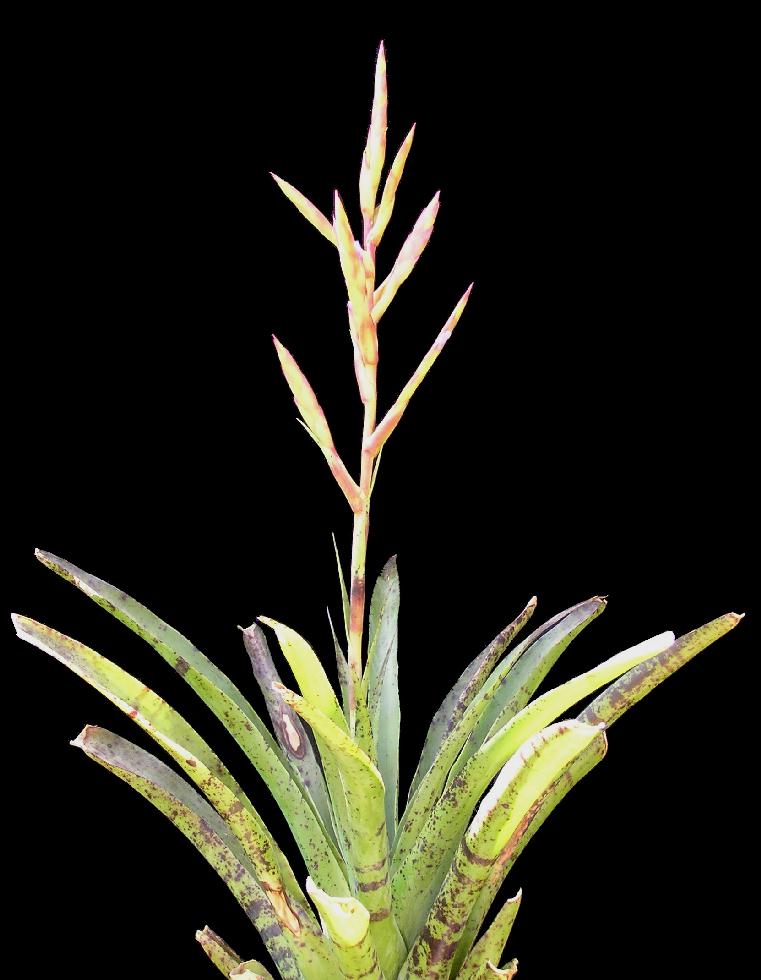
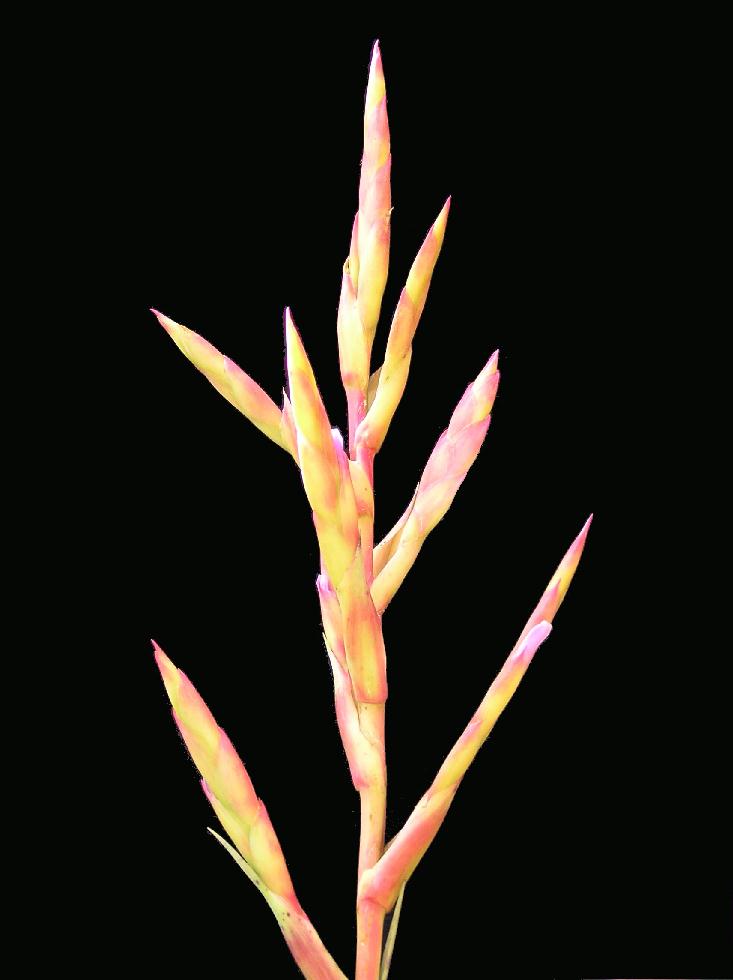
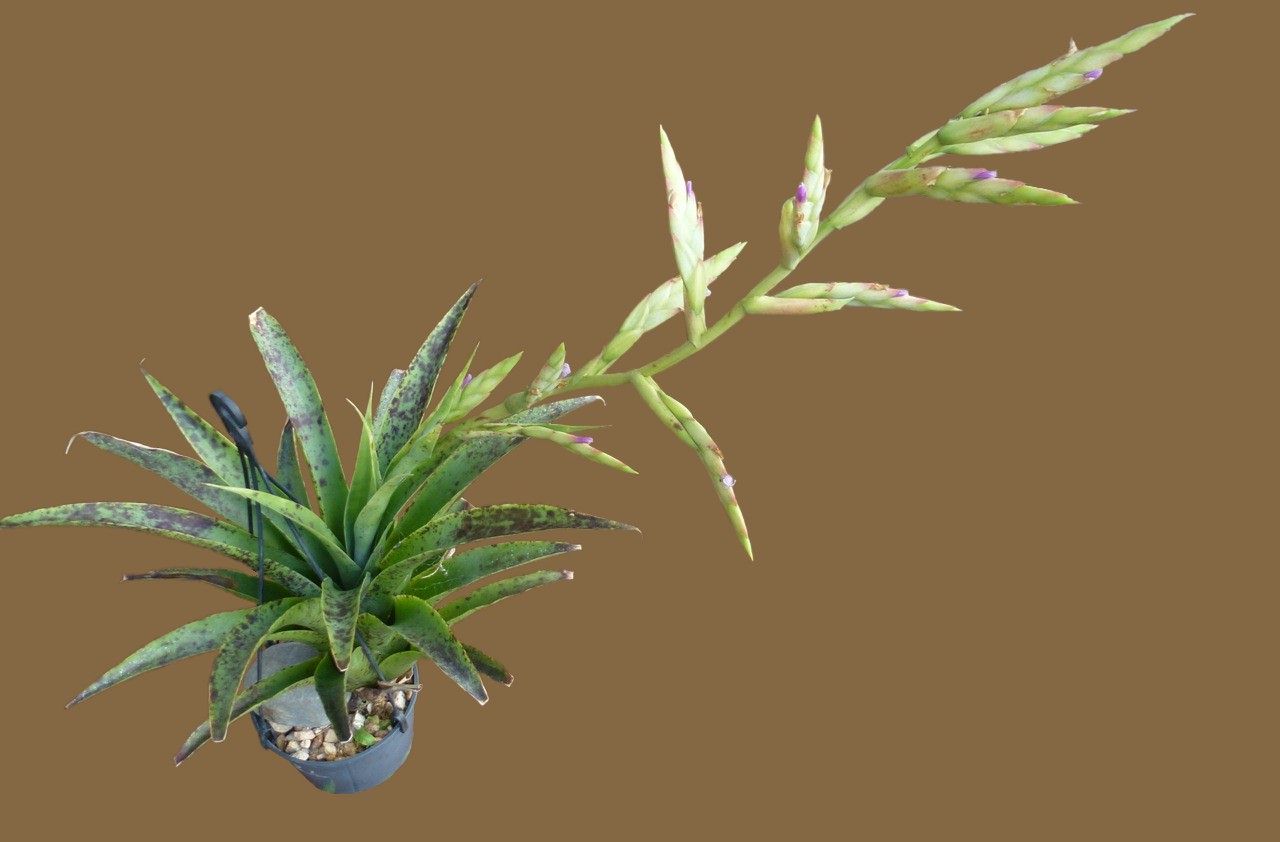
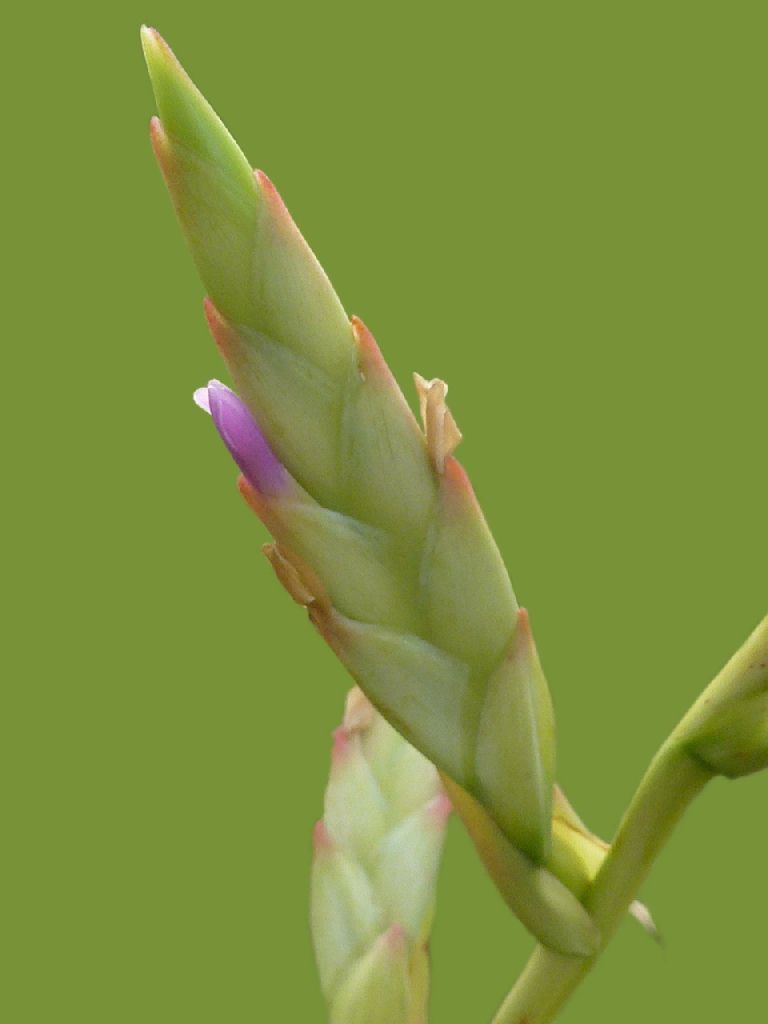
| Ken Woods 04/09. |
Bruce Dunstan 12/12. |

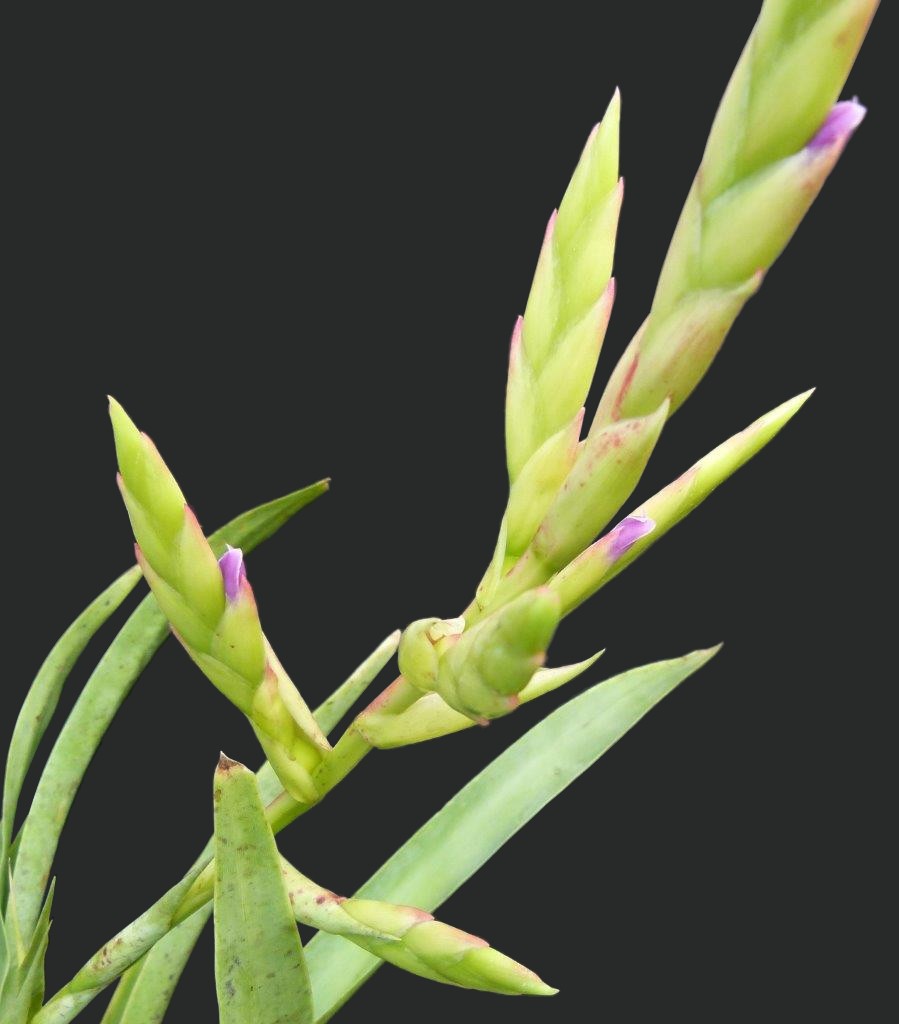
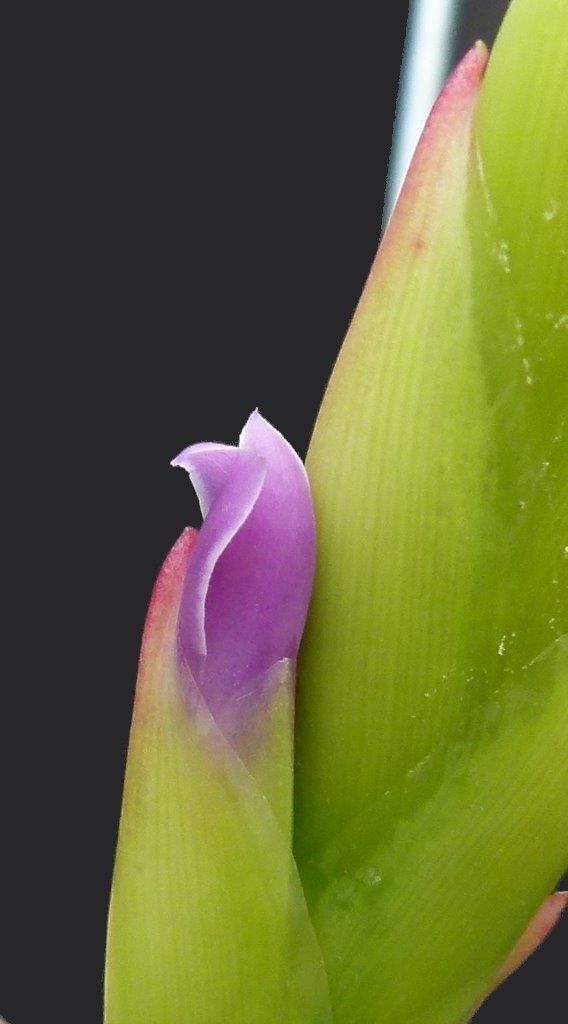
| Nanette Collingwood 03/20 |
Nanette Collingwood ... "This beautiful tillandsia is flowering for the first time for me. At the moment I'm not sure if the flowers will open more or if this is it."
Mark Supple ... "Iíve flowered this a few times now and flowers are like that for me too."
Peter Tristram ... "Mark is correct - thatís it - stamen and pistil included, like so many other Andean Tills. Quite a few clones in Oz too, with variation in size, shape, zonation, bract colour and leaf frosting. I got one from Heidelberg that I assume is the type. There are so many species that appear closely related, though without the zonations, especially from Karel Knize."
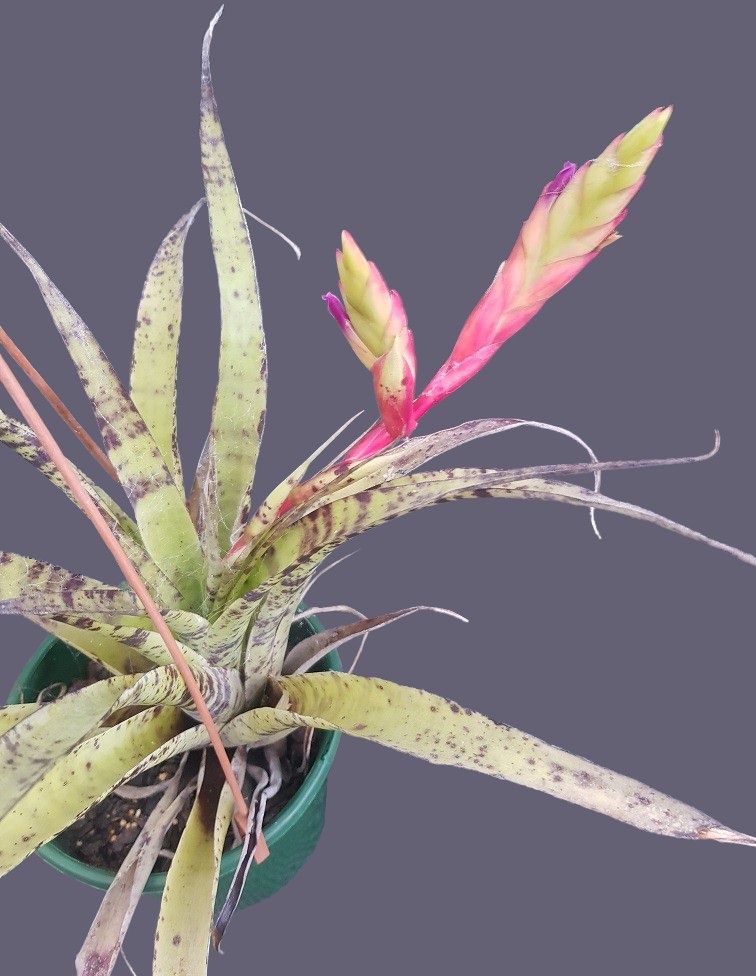
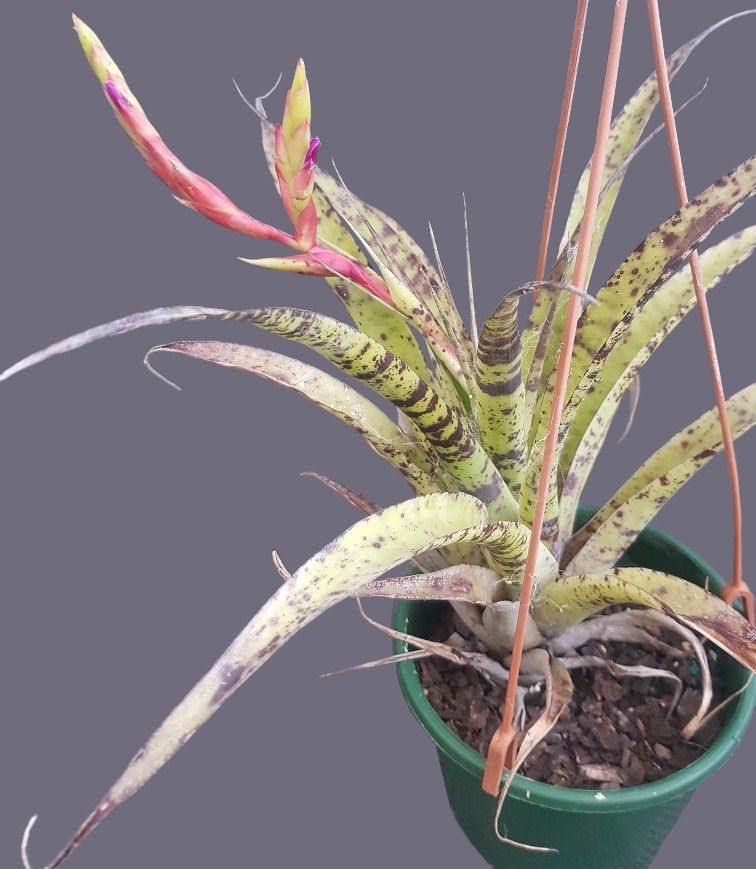
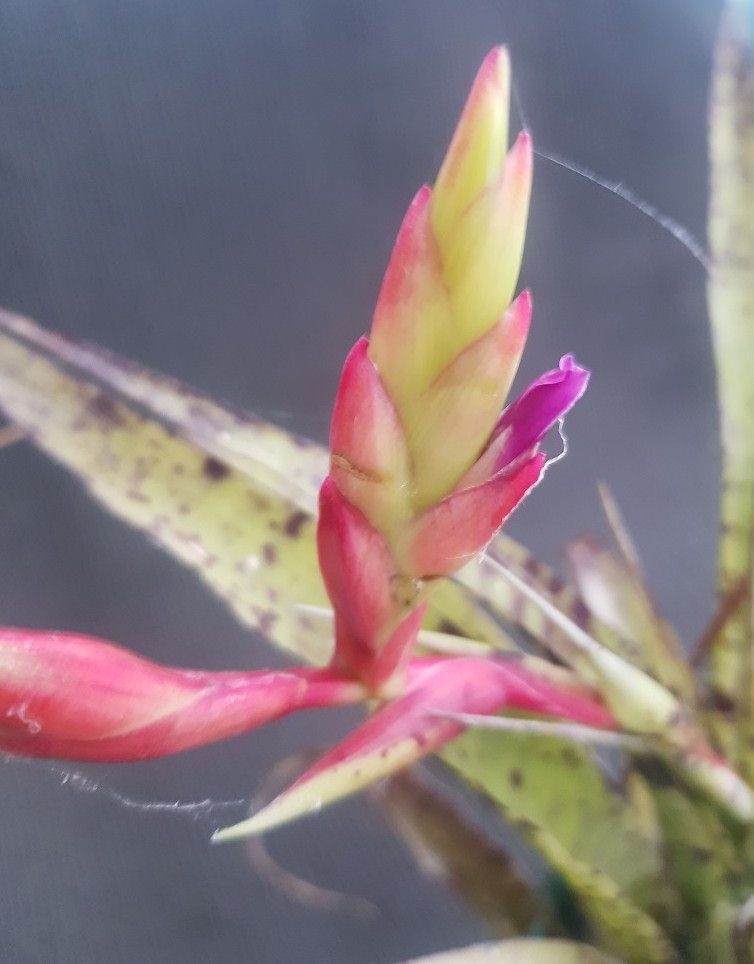
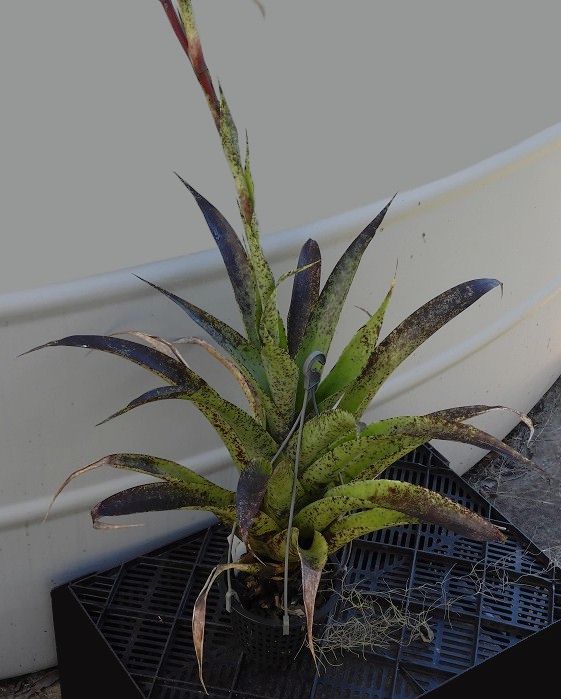
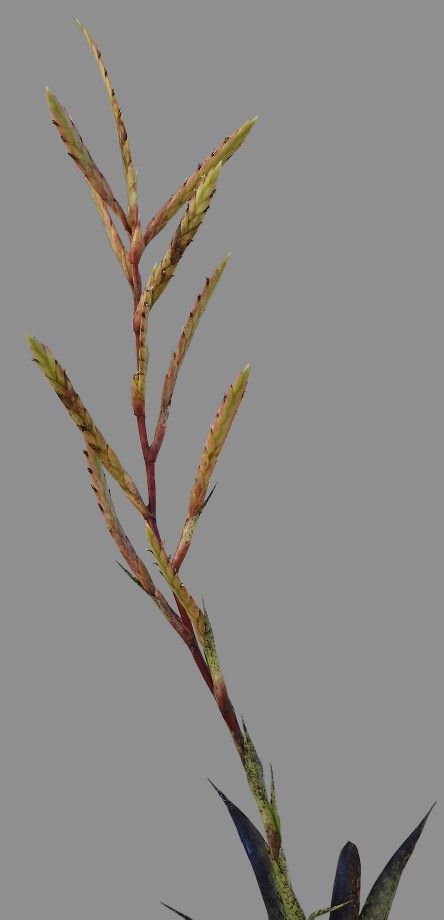
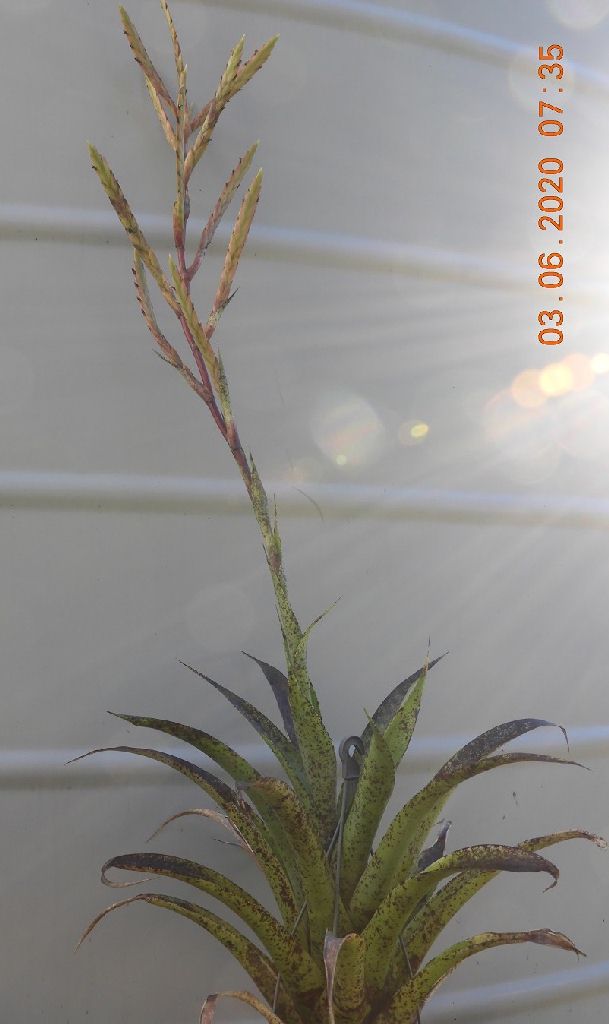 Greg Jones ... "Sorry to be critical Brenton but this is one Tillandsia that does enjoy fertilizer.
Greg Jones ... "Sorry to be critical Brenton but this is one Tillandsia that does enjoy fertilizer.
This my largest clone ex. Knize ex. Chris Larson, but the other two clones I have are only slightly smaller.
I see on the DVD there are pictures of other smaller roezlii, it would be interesting to know if this is cultural or if it is a very variable Tillandsia."
Brenton Cadd ... "Wow Greg, that is a beauty. I was aware that my plant was short on for inflorescence but I have four of these, one of which I have had mounted for about 10+ years, and this is the first one to flower so am excited about that. I have never fertilised until starting a regime in February this year after visiting Bruce Dunstan and seeing what he achieves. I will be looking for better results in the future and will be potting up my mounted plant."
Chris Larson ... "I have a form that grows to a size smaller than Brents in a heated greenhouse, even with regular fertilising. Yes there are forms and forms.
Brent's plants are grown here in Vic. without heating - many of these things become tender if pushed too hard in the cold. A slow difficult plant in this climate. So we tend to not fertilise as much between Mothers Day & Fathers Day (when the light is low), and leave dry longer between watering. Hence not so big and lush."
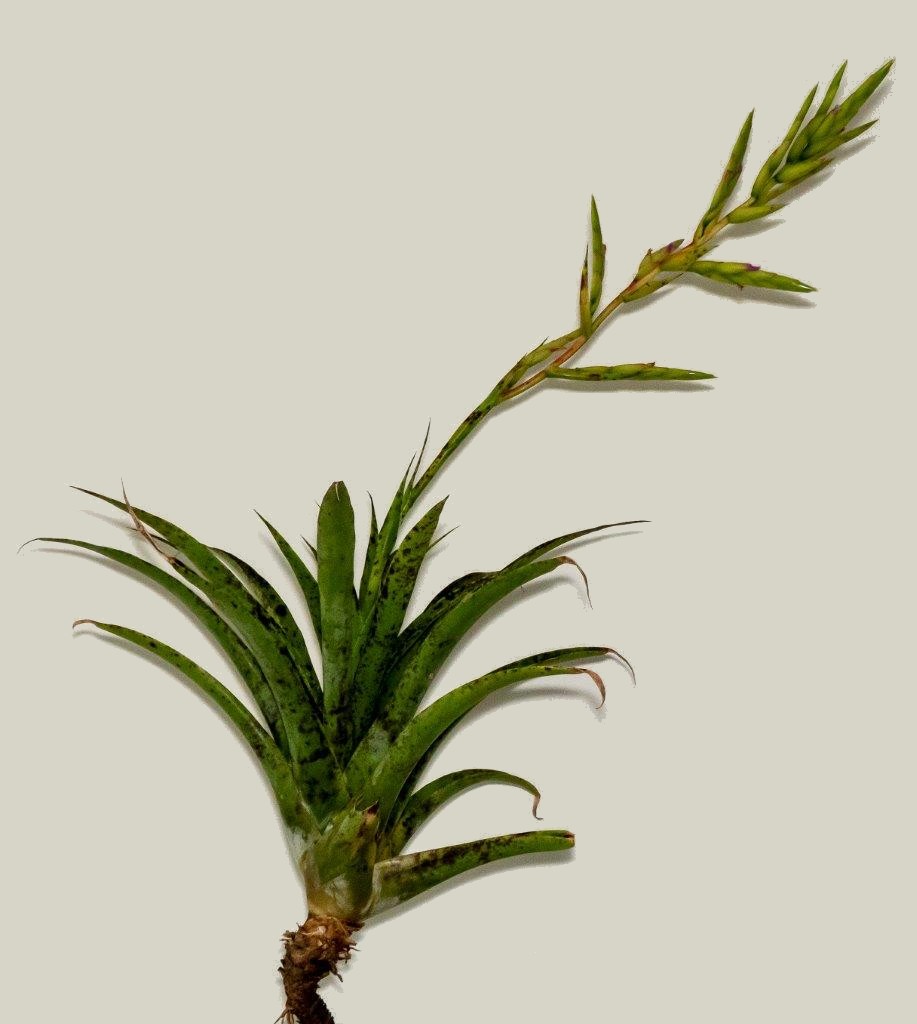

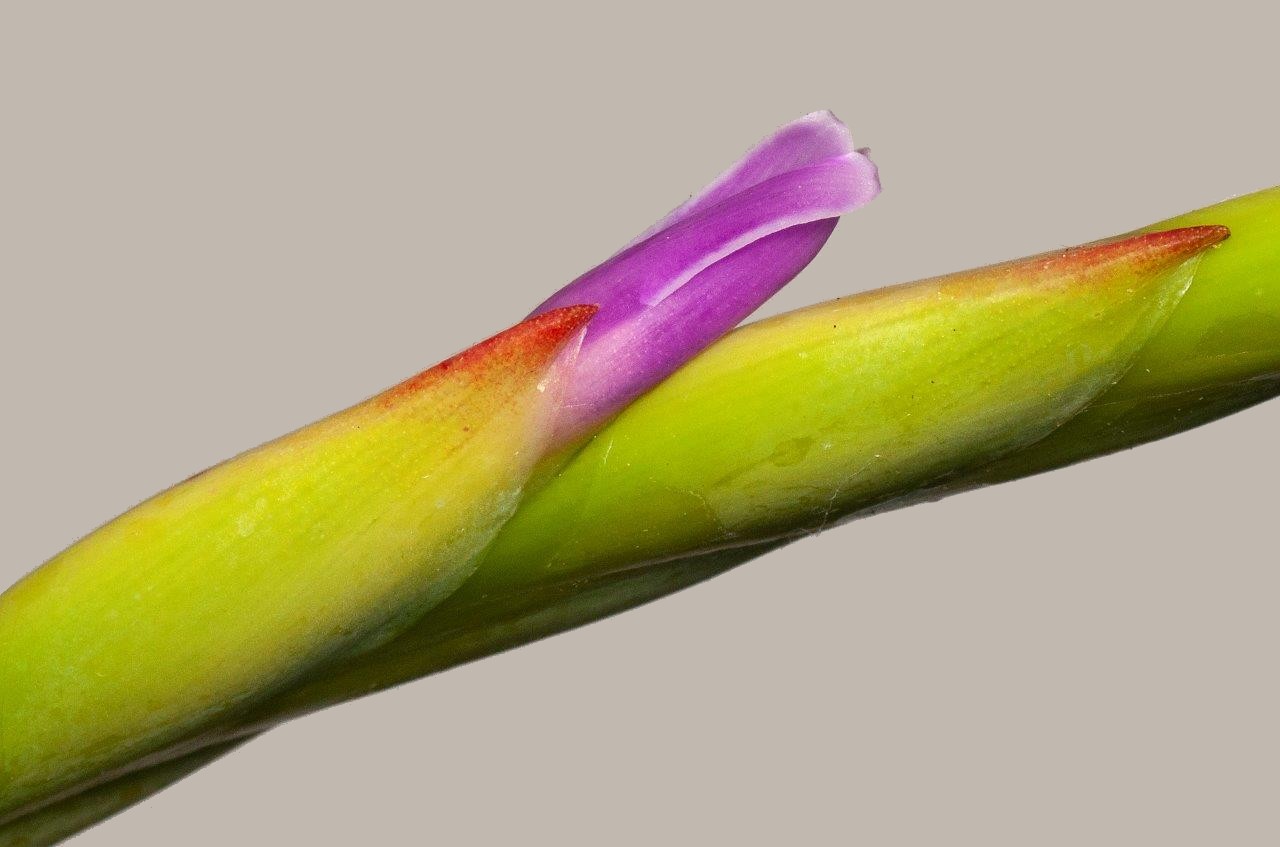




Tillandsia roezlii E. Morren, Belg. Hortic. 27: 272, pl. 15. 1877.
Allardtia roezlii E. Morr. ex Baker, Handb. Bromel. 207. 1889; Nomen.
Vriesea roezlii Hortus Linden ex E. Morren ex Baker, Handb. Bromel. 207. 1889; Nomen.
Tillandsia piurensis L. B. Smith, Phytologia 13: 146, pl. 6, figs. 25,26. 1966. see Kiff 1991
Desc from S&D p705 and p750 for T. piurensis which are shown in brackets
Plant stemless, flowering to 5 dm high. (flowering over 6 dm high.)
Leaves rosulate, 4 dm long; (probably rosulate. to 45 cm long, obscurely punctulate-lepidote throughout;)
Sheaths elliptic, slightly inflated; (broadly elliptic, scarcely distinct, ca 10cm long, dark castaneous above, concolorous with the blades beneath;)
Blades ligulate, acute, 35 mm wide, green with irregular brown-black cross bands, subglabrous ( narrowly triangular long-attenuate, 5 cm wide, pale green striated or marmorated dark purple-black (! Hutchison).)
Scape erect, about equaling the leaves, glabrous; (slightly curved but probably ascending, 6 mm in diameter)
Scape-bracts imbricate, lanceolate, acuminate, spreading at apex. (suberect, subfoliaceous, their bases exceeding the internodes but not altogether covering them.)
Inflorescence laxly bipinnate from a few spikes (bipinnate, 24 cm long, dense at apex, lax below;)
Primary bracts spreading, lanceolate, acuminate, shorter than the spikes, reddish;( ovate, the lowest slightly shorter than the reduced axillary spikes but with their blades exceeding them, the upper bladeless and less than half as long as the spikes;)
Spikes narrowly lanceolate, subsessile, 6-10 cm long, 16 mm wide (with 1-2 sterile bracts at base, the upper spikes lanceolate, acute, strongly complanate, 7-8 cm long, 2 cm wide (fruiting), 8-9-flowered.)
Floral bracts densely imbricate, lanceolate, acute, carinate, 3 cm long, exceeding the sepals, green with a red apex, lustrous.( imbricate and concealing the rhachis, elliptic, acute, carinate and slightly incurved toward apex, 25 mm long, equaling the sepals, coriaceous, even, glabrous;)
(Flowers subsessile.)
Sepals free, lanceolate, acuminate, the posterior carinate; (linear-oblanceolate, broadly acute, 24 mm long, thin, nerved, obscurely lepidote, the anterior free, the posterior connate for 6 mm, carinate.)
Petals naked, erect, 4 cm long, lilac;
Stamens included, filaments straight.
Type. Roezl s n (holotype LG ?, n. v.), probably in or near the department of Junin, northern Peru. In the absence of a specimen the original description and plate serve very well.
DISTRIBUTION. Known only from the type collection.
Tillandsia piurensis L. B. Smith, Phytologia 13: 146, pl. 6, figs. 25,26. 1966. Made synonymous with T. roezlii see Kiff 1991 p39
Desc from S&D
Plant flowering over 6 dm high.
Leaves probably rosulate. to 45 cm long, obscurely punctulate-lepidote throughout;
Sheaths broadly elliptic, scarcely distinct, ca 10cm long, dark castaneous above, concolorous with the blades beneath;
Blades narrowly triangular, long-attenuate, 5 cm wide, pale green striated or marmorated dark purple-black (! Hutchison).
Scape slightly curved but probably ascending, 6 mm in diameter, glabrous;
Scape bracts suberect, subfoliaceous, their bases exceeding the internodes but not altogether covering them.
Inflorescence bipinnate, 24 cm long, dense at apex, lax below;
Primary bracts ovate, the lowest slightly shorter than the reduced axillary spikes but with their blades exceeding them, the upper bladeless and less than half as long as the spikes;
Spikes subsessile with 1-2 sterile bracts at base, the upper spikes lanceolate, acute, strongly complanate, 7-8 cm long, 2 cm wide (fruiting), 8-9-flowered.
Floral bracts imbricate and concealing the rhachis, elliptic, acute, carinate and slightly incurved toward apex, 25 mm long, equaling the sepals, coriaceous, even, glabrous;
Flowers subsessile.
Sepals linear-oblanceolate, broadly acute, 24 mm long, thin, nerved, obscurely lepidote, the anterior free, the posterior connate for 6 mm, carinate.
Type. Hutchison & Wright 6616 (holotype US), cliff faces, Rio Huancabamba gorge 3-4 km below Huancabamba on the road to Sondor, 2000 m alt, Huancabamba, Piura, Peru, 16 Sep 1964.
DISTRIBUTION. Known from the type collection only.
TILLANDSIA PIURENSIS L. B. Smith, Phytologia 13: 146, pl. 6, figs. 25,26. 1966.
T. rubella Baker atque T. barbeyana affinis, a priore foliorum laminis haud ligulatis sed anguste tri-angularibus, bracteis florigeris laevibus, a posteriore floribus multo majoribus, a ambobus sepalis posticis inter sese connatis differt.
Plant flowering over 5 dm high.
Leaves probably rosulate, to 45 cm long, obscurely punctulate-lepidote throughout;
sheaths broadly elliptical, scarcely distinct, ca. 10 cm long, dark castaneous above, concolorous with the blades beneath;
blades narrowly triangular, long-attenuate, 5 cm wide, pale green striated of marmorated dark purple-black (! Hutchison).
Scape slightly curved but probably ascending, 6 mm in diameter, glabrous;
scape-bracts suberect, subfoliaceous, their bases exceeding the internodes but not altogether covering them.
Inflorescence bipinnate, 24 cm long, dense at apex, lax below;
primary bracts ovate, the lowest slightly shorter than the reduced axillary spikes but with their blades exceeding them, the upper bladeless and less than half as long as the spikes;
spikes subsessile with l-2 sterile bracts at base, the upper spikes lanceolate, acute, strongly complanate, 7-8 cm 1ong, 2 cm wide (fruiting), 8-9-flowered;
floral bracts imbricate and concealing the rhachis, elliptlc, acute, carinate and slightly incurved toward apex, 25 mm long, equaling the sepals, coriaceous, even, glabrous;
flowers subsessile.
Sepals linear-oblanceolate, broadly acute, 24 mm long, thin, nerved, obscurely lepidote, the anterior free, the posterior connate for 6 mm carinate.
P1. VI, fig. 25: Spike x1/2; fig. 26: Posterlor sepals x1.
PERU: Piura: Prov. Huancabamba: Cliff faces, Rio Huancabamba gorge 3-4 km below Huancabamba on the road to Sondor, alt. 2000 m, 16 Sept. 1964, P. C. Hutchison & J. K. Wright 6616 (UC, type).
Updated 28/07/24



















